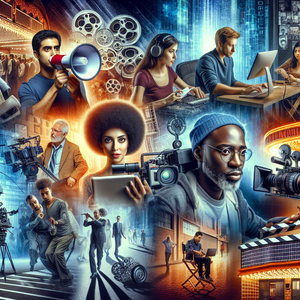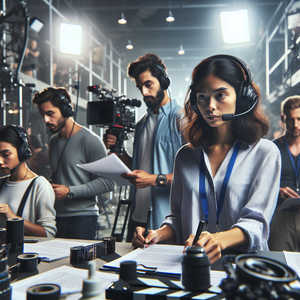The Art of Suspense: How Rigging Shapes Storytelling in Film

Rigging involves the use of ropes, cables, and mechanical equipment to support and control various elements on a film set. While it may seem like just a technical necessity, the way rigging is executed can profoundly influence a scene's emotional impact. For instance, the use of a pulley system to create a slow-motion descent can evoke feelings of suspense or gravity, while dynamic rigging can amplify action sequences, making them more exhilarating. To illustrate this, consider the iconic scene in Inception where gravity-defying action takes place in a hotel hallway. The seamless integration of rigging allowed actors to perform complex stunts that would not have been possible otherwise. By collaborating closely with directors and cinematographers, riggers ensure that their work aligns with the creative vision, enhancing the overall storytelling.
Innovative Techniques in Rigging
As technology advances, so do the techniques used in rigging. Modern rigging involves a mix of traditional methods and cutting-edge technology, such as computer-aided design (CAD) software and automated rigging systems. These tools not only improve safety but also allow for greater creativity in how scenes are constructed. For example, in the recent blockbuster Spider-Man: No Way Home, the rigging team utilized advanced automation to create complex aerial stunts that involved multiple characters swinging through the air. The ability to program precise movements meant that the action looked fluid and natural, significantly contributing to the film's thrilling visuals. Additionally, rigging can also be used to create illusions that enhance storytelling. In The Lord of the Rings, miniature rigging systems were employed to create the illusion of size differences between characters, making the Hobbits appear smaller than their human counterparts. This clever use of rigging not only supported the plot but also added depth to the film's fantastical world.
Interviews with Industry Professionals
To gain deeper insights into the relationship between rigging and storytelling, we spoke with several industry professionals. Renowned director Christopher Nolan emphasized the importance of collaboration: "The riggers are the unsung heroes of our films. Their ability to turn our visions into reality allows us to tell stories in ways that feel authentic and immersive." Similarly, veteran rigger Sarah Johnson noted, "Every time we rig a scene, we're not just thinking about safety; we're considering how to evoke emotion. It’s about crafting an experience that resonates with the audience." This sentiment reflects a shared understanding among filmmakers that rigging is fundamental to achieving the desired narrative impact.
Rigging Companies in Los Angeles
The film industry in Los Angeles is home to several prominent rigging companies that contribute to the art of suspense in storytelling. Companies such as Famous Productions, Hollywood Riggers, and Stage Rigging specialize in providing innovative rigging solutions tailored to the unique demands of each project. - Famous Productions has built a reputation for its extensive experience in both rigging and safety. Their expertise spans a variety of genres, from action-packed blockbusters to intimate dramas, ensuring that each scene is executed flawlessly. - Hollywood Riggers is known for its commitment to creativity and technical excellence. They have been involved in numerous high-profile projects, pushing the boundaries of what can be achieved through rigging. - Stage Rigging focuses on automated rigging systems, allowing for intricate movements and effects that enhance the visual storytelling experience. Their investment in technology ensures that filmmakers can realize their most ambitious visions. These companies, among others, highlight the collaborative nature of rigging in filmmaking. They work closely with directors, cinematographers, and production teams to create scenes that are not only visually stunning but also deeply resonant with audiences.
The art of rigging is an indispensable part of filmmaking that significantly shapes how stories are told on screen. By creatively integrating their work with the director's vision, riggers not only support the physical elements of a scene but also enhance the emotional experience for the audience. As the film industry continues to evolve with technological advancements, the role of rigging in storytelling will only become more vital. In celebrating the artistry and innovation behind rigging, we acknowledge the unsung heroes who help transform scripts into visually stunning narratives, ensuring that the art of suspense remains an integral part of the cinematic experience.
Rigging Technician
Warner Bros., Universal Pictures, Famous Productions
Core Responsibilities
Design and set up rigging systems for various film scenes, ensuring safety and creativity in stunt execution.
Collaborate with directors and cinematographers to achieve the desired visual effects, adjusting rigging based on scene requirements.
Maintain and troubleshoot rigging equipment to ensure flawless operation during shoots.
Required Skills
Proficiency in rigging techniques, including the use of pulleys, cables, and automated systems.
Strong understanding of safety protocols and industry standards in rigging.
Experience with CAD software for designing rigging layouts.
Stunt Coordinator
Paramount Pictures, 20th Century Studios
Core Responsibilities
Develop and oversee complex stunt sequences, including rigging for aerial stunts and fight choreography.
Train actors in stunt performances, ensuring their safety while maintaining the scene's authenticity.
Work closely with the production team to integrate stunts seamlessly into the narrative.
Required Skills
Extensive knowledge of stunt techniques and safety measures, as well as experience in film production.
Strong leadership and communication skills to manage stunt teams and collaborate with various departments.
Certification in stunt training or relevant experience in martial arts or gymnastics.
Visual Effects (VFX) Supervisor
Industrial Light & Magic, Weta Digital, Framestore
Core Responsibilities
Oversee the integration of rigged elements with CGI to create seamless visual effects that enhance storytelling.
Collaborate with riggers and cinematographers to ensure visual coherence between practical effects and digital enhancements.
Manage a team of VFX artists, ensuring that the final product aligns with the director’s vision.
Required Skills
Strong understanding of both practical and digital effects, with experience in VFX software such as Maya or Nuke.
Ability to visualize and communicate complex visual concepts to the production team.
Experience working on high-budget films with intricate visual sequences.
Motion Capture Technician
Sony Pictures Animation, Ubisoft
Core Responsibilities
Set up and operate motion capture systems to record actors' performances for use in animated films or video games.
Work alongside rigging teams to ensure accurate data capture that translates well into animated models.
Collaborate with directors and animators to optimize motion capture for storytelling purposes.
Required Skills
Proficiency in motion capture technology and software, such as MotionBuilder or Blender.
Strong understanding of animation principles and how they relate to live-action performances.
Experience in troubleshooting technical issues during shoots and optimizing setups for various environments.
Production Designer
HBO, Netflix
Core Responsibilities
Create the visual concept of a film or television show, including the design of sets that incorporate rigging elements for storytelling.
Collaborate with riggers to ensure that set designs accommodate necessary rigging for stunts or special effects.
Work closely with directors and cinematographers to align visual aesthetics with the narrative tone.
Required Skills
Strong background in art direction, set design, and a keen eye for detail in visual storytelling.
Proficiency in design software, such as SketchUp or AutoCAD, for creating set layouts and designs.
Experience working within a collaborative environment, effectively managing multiple aspects of production design.


